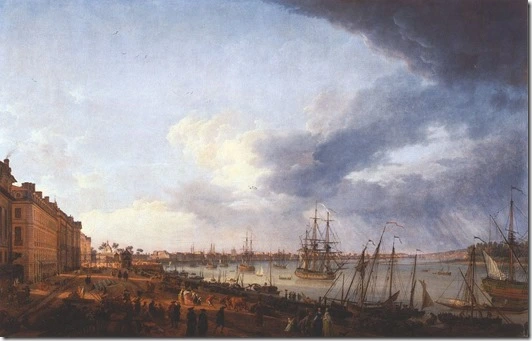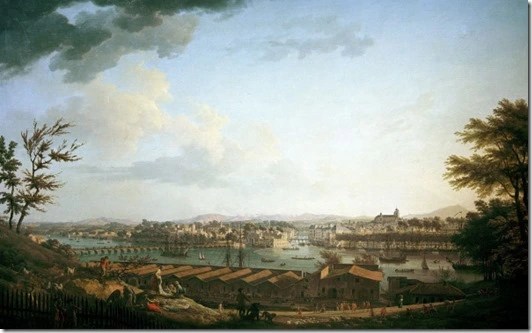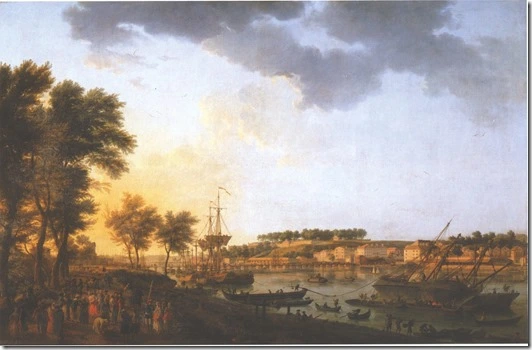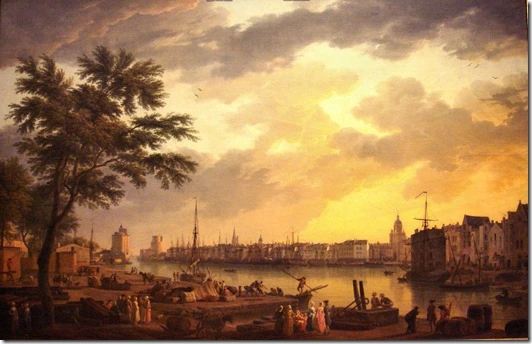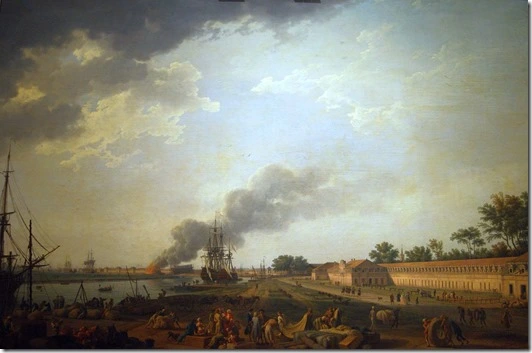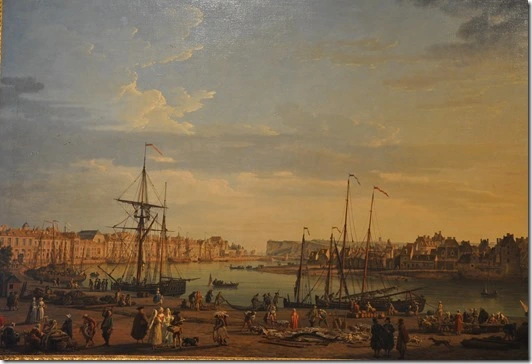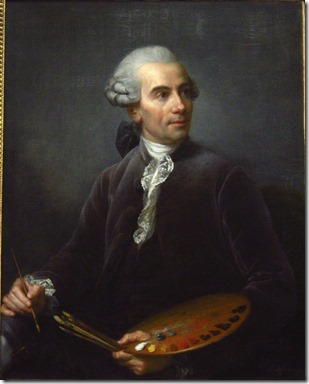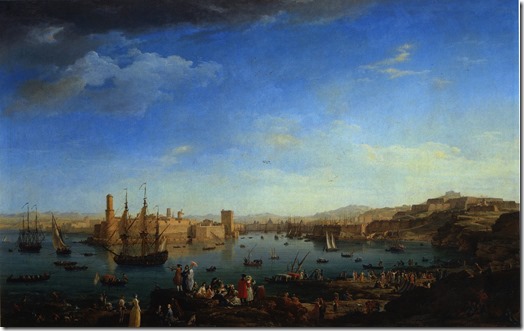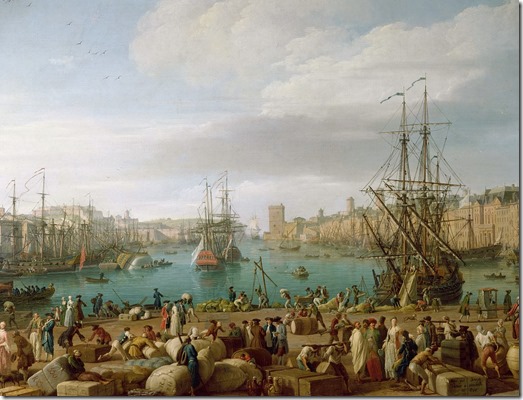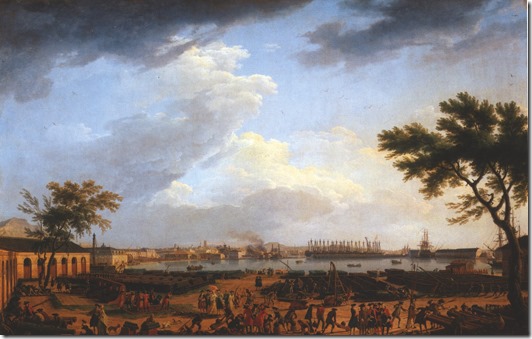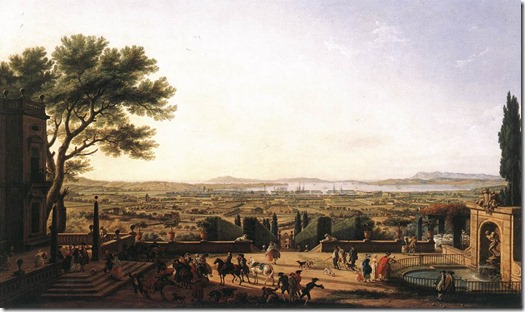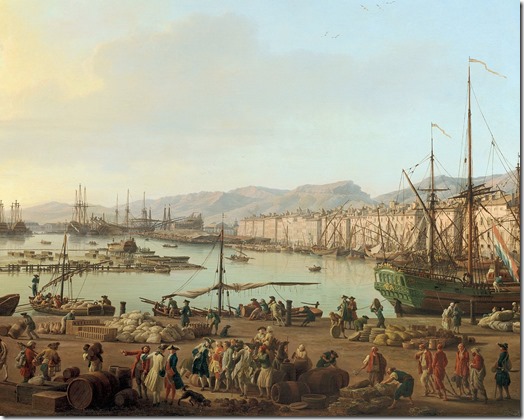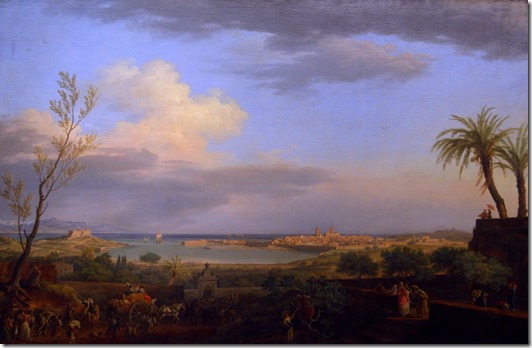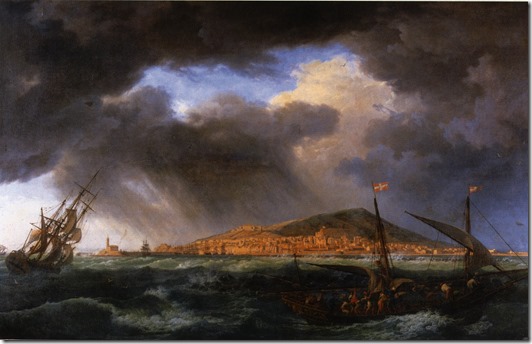Tags
18th century painting, French painting, Joseph Vernet, les ports de France, marine painting, ports of france
I suppose my choice of Joseph Vernet as the subject of no less than three posts on this blog might be seen as questionable. It is not my intention to attract hundreds of readers by writing about the Impressionists or Vincent Van Gogh, but to present and discuss artists whose work is significant and provides a context to the work of better known artists. I have never believed in a “greatest hits” approach to my personal research or curatorial endeavours, and have always found great satisfaction in discovering artists lesser known today, but whose work is nonetheless worthy of attention and study. Vernet fits the bill admirably.
He was, by all accounts, a modest man, but witty and well-educated; he functioned well in a society where notable people held “salons” for intelligent discussion on a wide range of subjects such as philosophy and literature. An evening’s entertainment might also include musical and dramatic performances. There is even some evidence that during his stay in Italy, Vernet befriended the young Giovanni Battista Pergolesi (1710-1736) and that Pergolesi performed the opening of his famous Stabat Mater on Vernet’s harpsichord in 1736. The autographed manuscript of its opening bars was one of Vernet’s treasured possessions until the day of his own death in 1789.
This was the Age of Enlightenment in France, and we have to imagine Vernet in this social context, as well as in the more solitary activity of the artist sketching in nature, and working on his large canvases of the ports of France in the studio.
He began work on the French ports of the Atlantic in 1757, as part of a larger royal commission to paint all the ports of France.
Bordeaux
Joseph Vernet: Première vue de Bordeaux : prise du côté des Salinières, 1758, 165 x 263 cm, Musée national de la Marine, Paris
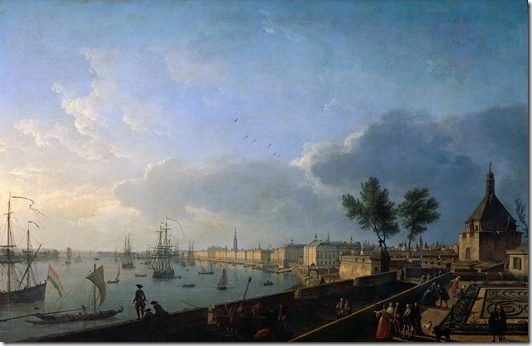 Joseph Vernet: Deuxième vue de Bordeaux : prise du château Trompette, 1759, 165 x 263 cm, Musée national de la Marine, Paris
Joseph Vernet: Deuxième vue de Bordeaux : prise du château Trompette, 1759, 165 x 263 cm, Musée national de la Marine, Paris
Vernet arrived in Bordeaux in May of 1757, and he and his family were to stay there for two years. They were well received by Bordeaux society, and Vernet also received small commissions which contributed to the well-being of his family.
By then, the Seven Years War (1756-1763) was in progress, and to us in Canada the War had serious repercussions, as France lost her North American colonies to Great Britain in a series of decisive battles: Louisbourg (1758), Québec (1759) and Montréal (1760). It is during this critical period that Vernet was painting his series on the ports of France. This was no doubt part of the reason he had to obtain all kinds of authorizations to sketch the ports, a source of delays and frustrations. The Seven Years War which ended with the Treaty of Paris in 1763. By then, King Louis XV had apparently uttered that there were more French ships in Vernet’s paintings than in its Navy.
Vernet decided that two views of Bordeaux would best represent the activities of this important port. He suggested that both views would be from the Chateau Trompette, the first featuring the chateau itself, along with a grand view of the city and the port. The other view was on the other side, towards the port for foreign vessels. He was amiably received by the Marquis de Tourny who was in charge of the many changes taking place in the port at the time. While it was decided that the buildings would be painted as could then be seen, by the time the the paintings were finished, Vernet had more or less represented the buildings as if completed, with more vessels in port, and the setting would be in peace time. The official instructions had mentioned that the export of French wines was an important activity in this port.
Both paintings were ready to be sent by special courier to the Marquis de Marigny in Paris by July 1759, who was delighted with the results. They were shown in the Salon of 1759, and attracted favourable comments, including from Denis Diderot who found in the works of Vernet imagination, fire, wisdom, colour, detailing and variety. Apparently there were no less than 14 or 15 works by Vernet at the Salon that year.
Bayonne
Joseph Vernet: Première vue de Bayonne, prise à mi-côte sur le glacis de la Citadelle, 1760, 165 x 263 cm, Musée national de la Marine, Paris
Joseph Vernet: Deuxième vue de Bayonne, prise de l’allée des Boufflers, près de la porte de Mousserole, 1761, 165 x 263 cm, Musée national de la Marine, Paris
Vernet at first intended to leave his family in Bordeaux while painting his intended view of Bayonne, where he arrived in July of 1759, but he was delighted with the city and since the cost of living was cheaper, he decided to bring his wife and two sons to Bayonne. He also decided on two separate views of Bayonne, because once again, a single painting would present a very incomplete view of the port, and Marigny agreed to two paintings. Delays in payment apparently contributed to the delays in completing these works since Vernet once again had no choice but to accept other commissions to make ends meet.
The works were sent to Paris in June of 1761 and were exhibited at the Salon. Diderot, in his critique, regretted that the time of day chosen for these works, sunset, obscured much of the activity and the figures painted in the foreground. While the official instructions had suggested the motif of privateers returning to port with their prizes (as they had been very successful at this during the Seven Years War), Vernet chose to represent local activities and entertainments. Rather than depicting a storm as suggested, Vernet chose the calm of sunset.
La Rochelle
Joseph Vernet: Vue du port de La Rochelle, prise de la petite Rive, 1762, 165 x 263 cm, Musée national de la Marine, Paris
Rochefort
Joseph Vernet: Vue du port de Rochefort, prise du Magasin des Colonies, 1762, 165 x 263 cm, Musée national de la Marine, Paris
By July 7, 1761, Vernet had moved on to La Rochelle. Because of swamps near Rochefort (not too distant from La Rochelle in any case) Vernet was concerned about epidemics and intended on working in Rochefort only during the ‘healthy’ season. He would stay in Rochefort twice—in November of 1761 and in February of 1762. While all the studies for the paintings of La Rochelle and Rochefort were done over the period of less than a year, at long last a studio vacancy in the Louvre occurred and Vernet was authorized and encouraged to move to Paris where he could complete the views from his studies and sketches. This he did in July and the paintings were finished by the time Vernet turned to the painting of Dieppe.
The views of Rochefort (in the morning) and La Rochelle (at sunset) were extremely well received both at court and upon their exhibition at the Salon of 1763.
Dieppe
Joseph Vernet: Vue du Port de Dieppe, 1765, 165 x 263 cm, Musée national de la Marine, Paris
Vernet finally settled in Paris in 1762. The original commission had included many of the ports of the Atlantic, but after Bordeaux, Bayonne, La Rochelle, Rochefort, had been painted, Vernet received permission to do a painting of Dieppe, which was not on the original list. He stayed in Dieppe for six weeks and was back in Paris before the end of October. He was delighted with Dieppe, a fishing port, and he worked on the painting in Paris, completing it in 1765, in time for the Salon of that year. By then, the commission was discontinued for lack of funds. The ports of Brittany and of Normandy would not be painted by Vernet.
Le Havre was only beginning to develop as a port of any significance, but had been on the list as were Calais, Dunkerque, Port Saint-Louis, Brest, Lorient and Saint-Malo.
Thirty years later, after Vernet’s death, the Revolutionary government commissioned the artist Jean-François Hue (1751-1823) in 1791 to complete the series, and so he painted three views of Brest, and views of Lorient, St-Malo, Granville and Boulogne. By all appearances, he lacked Vernet’s abilities, certainly as far as the treatment of water and the painting of figures.
While Hue had also been appointed as the French state’s official marine painter, there would be no marine painters in France achieving the fame and stature of Joseph Vernet.
He ended his days in Paris. He was never short of commissions, and although his work was in decline, his reputation had long been international, and the popularity of his work was only increased by its reproduction through the medium of engraving. He was not forgotten, and some notable biographies of his life were published during the 19th century, as well as appreciative commentaries on his work. No history of marine painting can omit the name of Joseph Vernet.
© Roger H. Boulet, 2015
Works consulted:
— “Works of the Great Masters. Joseph Vernet.” in The Illustrated Magazine of Art, Vol. 1. No. 4, 1853, pp. 192-202.
Delaborde, Henri. Le paysage et les paysagistes en France depuis le XVIIIe siècle: Joseph Vernet. 1852. (Kindle edition – STAReBOOKS edition, 2013.
Demarcq, Marie Pierre. Joseph Vernet (1714-1789) : Les vues des ports de France. Paris: Musée national de la Marine, 2003.
Lagrange, Léon. Joseph Vernet et la peinture au XVIIIe siècle. – Paris : Didier. – 1864.
Miger, Pierre-Auguste. Les Ports de France peints par Joseph Vernet et Jean-François Hue, Paris, Lenormand, 1812, 126 p.
Bibliography:
A bibliography can be found on the website of the Musée national de la Marrine.

